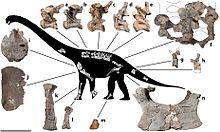| Savannasaurus Temporal range: Cenomanian–Lower Turonian, ~
| |
|---|---|

| |
| Skeletal diagram and selected fossils | |
| Scientific classification | |
| Domain: | Eukaryota |
| Kingdom: | Animalia |
| Phylum: | Chordata |
| Clade: | Dinosauria |
| Clade: | Saurischia |
| Clade: | †Sauropodomorpha |
| Clade: | †Sauropoda |
| Clade: | †Macronaria |
| Genus: | †Savannasaurus Poropat et al. 2016 |
| Species: | †S. elliottorum
|
| Binomial name | |
| †Savannasaurus elliottorum Poropat et al. 2016
| |
Savannasaurus is a genus of titanosaurian sauropod dinosaur from the Late Cretaceous Winton Formation of Queensland, Australia. It contains one species, Savannasaurus elliottorum, named in 2016 by Stephen Poropat and colleagues. The holotype and only known specimen, originally nicknamed "Wade", is the most complete specimen of an Australian sauropod, and is held at the Australian Age of Dinosaurs museum. Dinosaurs known from contemporary rocks include its close relative Diamantinasaurus and the theropod Australovenator; associated teeth suggest that Australovenator may have fed on the holotype specimen.
At 15 metres (49 ft) long, Savannasaurus was a medium-sized titanosaur. It is notable for its wide hips, which would have been over 1.1 metres (3 ft 7 in) wide at their widest points. This would have distributed its body weight more evenly, along with a robust humerus (upper arm bones) and possibly also the tall astragalus (ankle bone). Combined with a flexible vertebral column, these traits would have made Savannasaurus better at navigating the muddy ground of the floodplains that it lived on. Other titanosaur lineages also show some of these traits, which might have been independently acquired from similar environmental pressures.
Various traits suggest that Savannasaurus was an early-diverging (or basal) member of the Titanosauria, but not a member of the more specialized group Lithostrotia. Among these are the absence of hyposphene-hypantrum articulations in its vertebrae, which was one of the flexibility-enhancing traits that may have appeared in multiple titanosaur lineages. Palaeobiogeographic analyses suggest that the ancestors of Savannasaurus and Diamantinasaurus were from either Asia or one of the southern Gondwanan continents; regardless, they likely migrated to Australia through Antarctica around 105–100 million years ago.